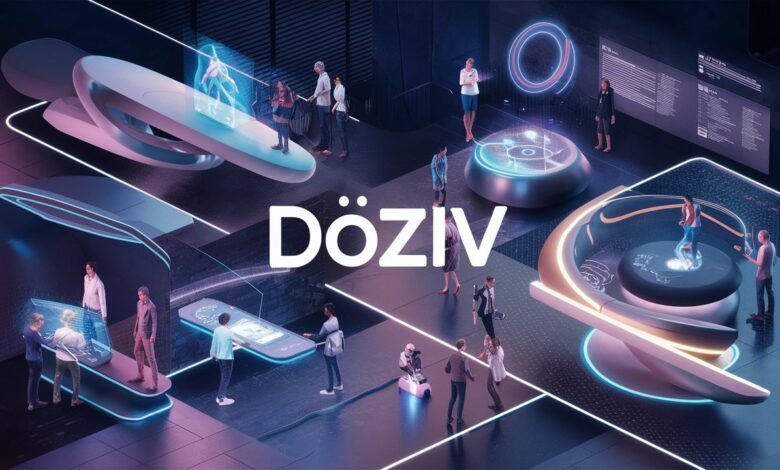Introduction
Over the past few years the digital landscape has evolved , evolved rapidly introducing new terms tools and platforms that define how companies operate , operate how people communicate and how developers innovate… One of the most recent emerging technological concepts gaining attention in online communities chat forums and discussions of early technology research is the dözv .
Although the term is relatively new and still evolving in technology circles it reflects a movement that combines the principles of distributed computing optimized data control and intelligent virtual integration of enterprise-wide applications. And oh yeah döziv is rumored to help companies manage multi-layered data flows protect digital assets facilitate automation reduce , reduce downtime and improve the end-user delivery experience.
As organizations move to hybrid cloud infrastructures remote collaboration tools emerge and cybersecurity concerns grow Dozev is emerging as a concept worth investigating. This , This article explains what tsiv means how it works its real-world applications challenges future opportunities and why a bunch of experts believe tsiv , tsiv may be the invisible backbone of future software architectures.
Table of Contents
Understanding What Döziv Actually Means
Many readers searching for dözv feel confused because the term is not yet mainstream or widely documented in traditional encyclopedias or thick technical textbooks. Instead, dözv appears frequently in developer boards, cybersecurity blog panels, and experimental tech labs, where professionals use the term to describe a structural system that optimizes how digital resources communicate in a distributed environment.

To break it down simply, dözv combines the following concepts in a single logical ecosystem: distributed data routing, optimized verification of network checkpoints, and intelligent virtual layers that support integration between software elements. Rather than being a consumer-facing tool, dözv functions behind the scenes, ensuring that large-scale digital operations perform smoothly. Think of it as a manager orchestrating conversations between systems that would normally struggle to communicate effectively.
Why Döziv Started Gaining Attention
Large organizations frequently deal with multi-branch servers, remote workers, mobile-based operations, and cloud-hosted critical services. As a result, data redundancy, network lag, processing verification, and security threats have become major problems. Industry analysts noticed gaps in communication between server nodes, especially during peak hours. This is where dözv gained popularity. Engineers mention that döziv provides optimized routing protocols, verification algorithms, and virtualization mechanisms to ensure minimal system interruption. Companies exploring digital transformation strategies find döziv helpful because it keeps system integrity stable without forcing businesses to purchase expensive replacement infrastructure. Tech think-tanks even claim that döziv concepts could empower next-generation IoT devices, making them more secure and efficient.
How Döziv Works Behind the Scenes
The operational model of döziv revolves around creating smaller digital zones inside a larger environment. Each zone processes limited but efficiently packed data tasks. These virtual clusters communicate using a verification layer that checks for anomalies, network delays, or malicious interference. Whenever a miscommunication occurs, the dözv system reroutes the request through another pathway. It operates like a traffic controller for online data. Developers build döziv using modular frameworks, so organizations can plug or unplug additional nodes without interrupting workflow. The architecture simplifies software scaling dramatically. Most modern frameworks suffer when growing too fast, leading to memory overload or task collisions. dözv prevents those issues by distributing workloads intelligently.
Key Components Inside the Döziv Framework
To better understand its structure, consider the major internal building blocks:
- Distributed Routing Layer for guiding information between nodes.
- Verification Engine to check the credibility of each request.
- Virtual Integration Module that connects software fragments into one ecosystem.
- Adaptive Security Filters that auto-detect suspicious behavior.
- Load Balancing Core that spreads tasks evenly.
These components work together to deliver a stable digital environment regardless of peak traffic.
Industries Currently Experimenting With Döziv
Although döziv is still an emerging concept, early adoption is happening across various sectors. Enterprise cloud service providers are testing döziv modules to manage unpredictable workloads from their customers. Blockchain-based financial startups examine dözv strategies to accelerate transaction confirmations without sacrificing security. Meanwhile, healthcare data centers employ dözv principles to maintain patient record synchronization across distant branches. Gaming companies rely on its virtualized communication features to reduce gameplay lag and improve user experiences. Each of these industries benefits from dözv because it improves digital communication reliability while lowering operational costs.
Benefits of Implementing Döziv Solutions
Companies adopt döziv-based structures because they see multiple advantages that transform their workflow. Operational costs decrease since existing resources last longer through intelligent workload distribution. Downtime reduces because verification layers identify weak points before they collapse. Data security strengthens through adaptive filters that evolve against new threats. Scalability improves dramatically, enabling companies to add thousands of new users without overloading servers. Development teams gain confidence knowing that their backend won’t break under the weight of future updates. Customer satisfaction rises when applications respond rapidly even during busy periods.
Performance Comparison
| Feature Category | Traditional Systems | Döziv-Powered Architecture |
| Downtime Frequency | Medium to High | Extremely Low |
| Security Adaptability | Static Rules | Dynamic Filtering |
| Scalability | Limited | Easily Expandable |
| Operation Cost | Expensive | Affordable |
| Data Verification Speeds | Slow | Optimized |
Common Problems Before Döziv Adoption

Enterprises experienced several pain points before döziv concepts were introduced:
- Overloaded servers during traffic spikes
- Data desynchronization between remote branches
- Long verification times for sensitive information
- Expensive hardware upgrades
- Vulnerability to emerging cyberattacks
These problems slowed business growth, frustrated customers, and forced companies into unnecessary investments.
The Role of Verification in Döziv Architecture
One of the fascinating elements inside dözv is its highly optimized verification engine. Every request passes through multiple checkpoints that analyze patterns, identify inconsistencies, and evaluate dependencies. If the system detects unusual packet behavior or repeated unauthorized access attempts, it immediately blocks the chain and notifies administrators. Verification engines operate autonomously and rely on machine-pattern recognition to stay relevant. Large enterprises love this feature because it reduces the need for human oversight. It also protects sensitive information from modern cyberattacks. Since data-driven industries continue to expand, verification will remain a crucial backbone for digital safety.
Virtual Integration Layers and Their Importance
Virtual integration layers allow multiple software environments to work together harmoniously, regardless of the programming language used. Companies often use different coding platforms across departments, creating compatibility issues. Döziv integration layers translate requests so every system understands the conversation. It feels similar to a multilingual interpreter inside the digital world. Without such a layer, organizations waste weeks rewriting code just to match departmental standards. With dözv , developers can introduce new services without modifying their entire structure. That flexibility drives innovation faster than traditional methods.
Application Suitability Levels
| Industry | Suitability Level | Reason |
| Financial Services | Very High | Requires verification-heavy operations |
| Healthcare | High | Sensitive data synchronization |
| Education | Medium | Cloud-based content delivery |
| E-Commerce | Very High | Transaction scalability |
| Gaming | High | Live-lag reduction |
Challenges Linked to Döziv Deployments
Despite its strengths, dözv faces several challenges. The first hurdle is a lack of trained professionals capable of installing and maintaining dözv -based systems. Because the concept is emerging, educational programs have not yet integrated dözv modules into their curriculum. Many companies struggle to switch from outdated systems due to compatibility conflicts. Additionally, implementation costs may be higher during the initial setup phase, and businesses operating in conservative sectors may hesitate to adopt unfamiliar frameworks. Another challenge includes potential errors in early-stage verification algorithms, which require frequent updates to maintain accuracy. However, these obstacles fade gradually as more researchers publish findings and improve core technologies.
Future Potential of Döziv
Experts predict that döziv will influence cloud computing frameworks dramatically over the next five years. Hybrid cloud systems, decentralized finance platforms, organization-wide automation utilities, and AI-driven communication tools will rely heavily on dözv principles. Some researchers believe dözv could eventually merge into Internet infrastructure itself, accelerating online communication speeds and closing security loopholes. Countries investing in digital identity management may implement döziv-based verification layers to prevent identity theft. Blockchain developers imagine using dözv to decrease transaction congestion. With such wide possibilities, döziv has potential to join the top tier of technologies powering digital transformation.
Security Enhancements Driven By dözv Intelligence
Cybercriminals evolve daily, making static firewall rules ineffective. Döziv addresses these problems by learning from patterns. Each attempted attack is analyzed, categorized, and blocked if it matches harmful behavior. Attack logs improve filter accuracy. This adaptive response ensures that once a threat is identified, future attempts fail. Modern security races require continuous adaptation, where dözv shines. Enterprises dealing with customer financial data benefit the most, as do e-commerce platforms facing payment fraud attempts. With dözv in place, businesses reduce risk, improve brand reputation, and avoid costly legal penalties.
Impact of Döziv on Development Teams
Developers often face deployment delays due to complex backend frameworks. dözv regularly without creating system instability. It also reduces stress levels within IT departments since downtime becomes rare. Smooth workflows translate into faster product launches, better user satisfaction, and improved brand loyalty. Döziv also enables teams to direct their creativity toward innovation instead of constant troubleshooting.
User Experience Improvements Through Döziv Optimization

End-users may never hear the word döziv, but they benefit from its existence daily. Applications respond instantly, webpages load quickly, payments process securely, and customer support portals stay active even when millions of users connect simultaneously. These invisible improvements shape digital trust. When people rely on platforms without delay or errors, they continue using them. That trust increases profit margins for businesses, creating a cycle of growth powered silently by dözv principles.
Is Döziv Expensive to Maintain?
Maintenance depends largely on company size and system complexity. dözv reduces long-term costs by lowering server stress, preventing hardware overuse, and cutting downtime-related losses. Although initial deployment may require skilled labor, organizations view this expense as an investment. Over time, operational savings exceed implementation costs. Companies adopting döziv report fewer emergency repairs, improved employee productivity, and better overall digital performance.
Global Interest and Adoption Trends
Technology reports indicate that interest in döziv is rapidly rising across Asia, Europe, and parts of North America. Many universities are establishing research projects to explore dözv optimization algorithms. Startup accelerators hold hackathons encouraging students to build dözv -compatible applications. Government agencies also examine dözv -inspired frameworks to improve national cybersecurity strategies and digital census processes. These trends suggest that döziv is transitioning from a niche concept into a global conversation.
Conclusion
Döziv attracts the attention of digital leaders because it provides answers to problems that , that most systems have difficulty solving. The combination of distributed routing, control , control intelligence, virtual integration and adaptive security positions it as a strong foundation for modern infrastructure. And oh yeah, While challenges such as lack of training and initial setup costs may temporarily slow , slow adoption, the long-term benefits far outweigh the obstacles. Whether used in banking, healthcare, gaming or government authentication services, tsiv-based systems provide unparalleled stability, security and scalability. As digital transformation accelerates worldwide, utuziv has the opportunity to become , become a quiet but powerful force in shaping the future of software ecosystems.
FAQs
1. Is dözv a physical product or digital framework?
dözv is a digital architectural concept rather than a tangible product, focusing on optimization, verification, and virtual integration.
2. Can small businesses benefit from döziv?
Yes, small businesses can use dözv principles to reduce operational costs, improve security, and scale efficiently.
3. Does döziv replace cloud providers?
No, it enhances existing cloud environments by improving data routing and verification performance.
4. Is dözv difficult to install?
Setup requires trained professionals initially, but once implemented, maintenance becomes relatively stable.
5. Will dözv remain relevant in the future?
Experts predict it will grow more relevant as digital communication becomes increasingly complex.
Also Read This: Understanding rwu uar:Best Powerful Insights for Users
